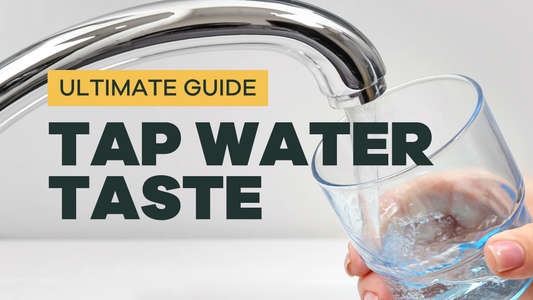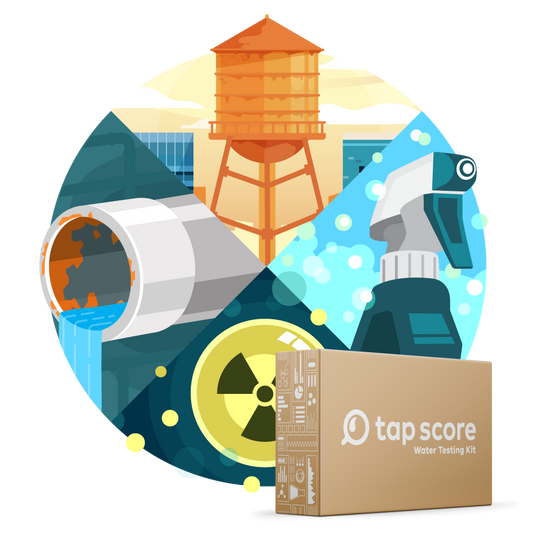
How Does Ion Exchange Work?
Our blog is written by real experts— not AI. Each guide is carefully reviewed and updated based on the latest research. Plus, with no affiliate links, you can count on unbiased insights you can trust.
While insoluble pollutants can be removed through multimedia filtration, soluble substances must be removed using other techniques.[1] This is where ion exchange (IE) comes into play. Ion exchange methods are often used to filter water when impurities are soluble and ionized.
-
Soluble: Any substance that can be readily dissolved in another substance (usually water).
-
Ionized: Any atom or molecule with a positive or negative charge (as opposed to being uncharged).
Before we dive into the different types of IE, let’s take a deeper look at what exactly happens during ion exchange.
What Is Ion Exchange?
In water, ions are created when water’s own polar bonds break ionic bonds of other atoms, causing them to lose or gain an electron. This results in positively charged ions, called cations, and negatively charged ions, called anions. Because water is electrically neutral, the amount of positive and negative charges present in the water is equal.
Water’s ability to dissolve ionic bonds allows it to hold many nutrients, chemicals, and minerals imperative to life on Earth. However, it also allows for dissolution of undesired impurities, like fluoride, radium, and strontium.
To remove these unwanted, ionized substances from water, ion exchange is utilized. In IE, contaminants are removed from water by exchanging the harmful substances with safer substances that have the same charge but no negative impact.
Ion Exchange Resins
Typically, IE systems have a pressure tank that is filled with ion exchange resin. Ion exchange resin consists of very small (often, polystyrene) beads. These beads, which are about ½ millimeter in diameter, are highly porous and are engineered to have special ions permanently attached to their structure.
How Does Ion Exchange Remove Impurities?


(1) When hard water flows through an IE system, the hardness ions (i.e. Ca2+, Mg2+) attach to the resin beads, (2) replacing two sodium counterions per ion of calcium. (3) The sodium ions leave the system in the "treated" water (not shown), (4) while the calcium ions are backwashed out of the unit.
When water flows through an IE filter, impurities, which are dissolved as ions, are attracted to the fixed ions on the resin beads with a higher affinity than the counterions. This attraction causes the impurities to attach to the fixed ions, replacing the counterions. In order for the resin to remain neutral, the counterions must leave the beads in the effluent water. This process allows for the unwanted ions to remain in the filter in exchange for nonpolluting ions, hence the term “ion exchange”.
It is important to note that for an IE filter to properly function, the incoming ions must have the same charge as the counterions. Therefore, it is important to establish the charge of the ion you are trying to remove before purchasing an IE filter.
At-home IE units typically have two or three tanks- one or two larger tank(s) filled with resin and a smaller tank filled with salt or chlorine, depending on the charge of the counterions. The smaller tank is used to periodically regenerate the resin media. As water passes through the resin, the beads become saturated with pollutant until all of the counterions are replaced. When this happens, the filter is no longer able to remove impurities, and the unit is normally programmed to automatically rinse the IE beads with salt or chlorine. This purges the system of pollutants and resets the system’s counterions.
IE units can be set to regenerate after set time intervals; however, setting a unit to rinse at preset times means that the system might regenerate more or less often than necessary. Regenerating more often than necessary wastes salt or chlorine (and water). Regenerating less often than necessary allows for unclean effluent water. More advanced, and expensive, units regenerate based on water use, resulting in higher efficiency and less waste.
Cation vs. Anion Ion Exchange Resins


There are two types of ion exchange resins. As the name suggests, cation exchange resins are used to remove positively charged contaminants, while anion exchange resins are used to remove negatively charged contaminants. Because the fixed ions can only be either cations or anions, in order to remove both cation and anion contaminants from water, you would have to have two separate tanks for each resin.
Often, cation exchange resins have sulphonates (SO3-) as their fixed ions, with sodium cations (Na⁺) as their mobile counterions. Anion exchange resins typically utilize quaternary ammonium cations (N⁺R3) as their fixed ions and chloride anions (Cl-) as their counterions.
Types of Ion Exchange
Ion Exchange: For Water Softening
Water softening is the most popular water conditioning process utilized by residential and commercial buildings in the USA. It is the principal approach towards removing water hardness, and there are several types of water softeners on the market.
What Is Water Hardness?
If your water glasses are cloudy, your hair is dull, and your soap isn’t, well, soapy, you might have hard water. While hard water isn’t physically hard, it is hard on your skin, appliances, and pipelines. Water hardness is a term commonly used to describe water that contains large amounts of positively charged dissolved minerals. Hardness mainly refers to dissolved calcium (Ca⁺⁺) and magnesium (Mg⁺⁺), but can also include other metallic elements, such as iron (Fe⁺⁺) and manganese (Mn⁺⁺).
The more calcium and magnesium in water, the higher the degree of hardness. Three measurements are used to identify the concentration of hardness and determine the degree of hardness of water:
-
GPG (grains per gallon)
-
mg/L (milligrams per liter)
-
PPM (parts per million)
Note: 1 mg/L is equivalent to 1 PPM. Hardness of water is normally calculated as the sum of magnesium and calcium concentrations measured in PPM CaCO3. The EPA outlines the different tiers of water hardness as follows (but there are many subjective interpretations of what constitutes hard and soft water):[2]
-
Soft Water: <50 PPM
-
Moderately Soft: 51-100 PPM
-
Slightly Hard: 101-150 PPM
-
Moderately Hard: 151-250 PPM
-
Hard: 252-350 PPM
-
Excessively Hard: >350 PPM
What Causes Hard Water?
As water travels through the Earth, it dissolves many minerals from the Earth’s crust. Therefore, groundwater is often hard water because it contains large concentrations of dissolved calcium and magnesium, both of which are very commonly found in rock and soil and along the seafloor.
Signs of Water Hardness
Fortunately, water hardness has no known health impacts. It does, however, have a number of aesthetic and technical effects. For example, hardness in water can precipitate into scale that can build up in your pipelines, causing decreased efficiency of household appliances, slower water flow rates, and even pipe blockages. Furthermore, water hardness can have effects on your body and well-being as well.
Signs that you have hard water include:
-
Cloudiness in drinking glasses
-
White scale in cooking pans
-
Dull hair
-
High energy costs
-
Rough Skin
-
Scale buildup in pipes
-
Stiff laundry
-
Soap doesn’t lather
-
Slimy feeling on hands after washing with soap
Despite hard water’s arguably superior taste, many households opt to install water softeners to avoid these costly and annoying issues.
How Do Water Softeners Work?
Water softeners are ion exchange units that soften water by exchanging hardness ions, mainly calcium (Ca⁺⁺) and magnesium (Mg⁺⁺) , with sodium (Na⁺) ions. Because calcium and magnesium are cations, water softening utilizes cation exchange resin. These cation exchange resins have sulfonate (SO3-) anions as their fixed ions and sodium (Na⁺) cations as their counterions. Potassium (K⁺) salt can also be utilized as a counterion. Both potassium and sodium are “soft” ions, meaning they don’t precipitate into scale; this makes them optimal for ion exchange.
As hard water flows through the pressurized tank, the hardness ions move into the resin beads, attaching to the fixed ions and replacing the sodium counterions. Because both calcium and magnesium are divalent, each hardness ion replaces two sodium ions in order to remain neutral. This exchange traps the hardness ions in the resin, allowing the sodium ions to leave the resin in the effluent water. In addition to calcium and magnesium, iron (Fe⁺⁺) and manganese (Mn⁺⁺) can also be removed in the water softening process.

Over time, as hard water flows through an IE system, the resin beads become saturated with hardness ions and must be recharged with counterions (normally sodium or potassium). Brine, which is water containing high levels of salt/sodium/potassium, is typically used to recharge (regenerate) resin media and the proper ongoing functioning of the IE system.
Typically, a water softener consists of two tanks, one cation resin tank and one smaller brine tank. When the resin beads become fully saturated with hardness ions and all of the sodium has been exchanged, the unit must regenerate. The system washes itself with brine, which is a solution of sodium chloride, to replace all of the hardness ions with sodium ions. After the process is complete, the brine and hardness ions are discharged out of a discharge pipe. Although effective, the regeneration process is very wasteful; the average water softener uses twenty-five gallons of water a day for regeneration.
Use Cases of Water Softeners
Water softeners are used to remove hardness ions and of course, soften water! Using soft water to do chores, bathe in, and supply to your house has many benefits, including:
-
Lower energy bills
-
Prolonged use of pipes and appliances
-
Soap lathers like a bubble bath, meaning less waste!
-
Smooth skin and silky hair
-
Cleaner dishes and clear glasses
Ion Exchange: For Fluoride Removal
What Are the Effects of Fluoride in Drinking Water?
Fluoride (F-) naturally exists in groundwater and surface water, as it is found in soil and bedrock. Depending on the concentration, fluoride has both positive and negative health effects on humans. At low levels, fluoride is known to reduce the rate of tooth enamel demineralization and prevent against cavities. It is because of this that many public water facilities fluoridate their water in order to improve dental health. While the benefit of fluoridation is clear, in higher concentrations, fluoride can have serious health impacts, such as dental and skeletal fluorosis. To prevent these effects, multiple methods are utilized to remove excess fluoride in water, including ion exchange.[3]
Why Is Fluoride Used in Water Treatment?
How Does Ion Exchange Remove Fluoride From Water?
Because over 95% of fluorine in water is present as fluoride (F-), strong-base anion resins are mainly used in IE defluorination. The fixed ions on the resin are quaternary ammonium cations, and the counterions are typically chlorine ions, or chloride (Cl-). As water flows through the resin tank, the fluoride ions, which have a higher electronegativity than chloride, attach to the resin in exchange for chloride ions. This process occurs until the resin becomes saturated with fluoride ions, at which point the system must be regenerated using a dissolved sodium chloride salt. During regeneration, the resin is recharged with chloride ions, and the fluoride rich water is discharged. In addition to anion exchange resins, cation exchange resins treated with alum solution can be used for defluoridation.[4]
Pros of defluoridation by ion exchange:
-
Very productive––More than 90-95% of fluoride is removed
-
Most effective at a neutral pH of 7
Cons of defluoridation by ion exchange:
-
Treated water has lower pH
-
Treated water contains a high concentration of chloride
-
Costly process
-
Discharged wastewater is fluoride rich (must be disposed of properly)
-
Longer reaction period required than other treatment methods
-
Other anions (phosphate, sulphate, etc.) interfere with fluoride removal
Quick Guide to Certified Water Filters for Fluoride
Ion Exchange: For Radium Removal
What Are the Effects of Radium in Drinking Water?
Radium is a radioactive element that is naturally found in the earth’s crust. Groundwater can contain radium (Ra⁺⁺) ions, depending on the concentration of radium in nearby soil and rocks. Because radium is a radioactive element, when consumed in high concentrations, radium can have negative health impacts. Some health impacts of radium include: [5]
-
Damage to body tissue via emitted alpha particles
-
Breast, liver, and bone cancer
-
Harm to immune system, teeth, and eyes
In order to avoid these effects, ion exchange can be utilized to remove radium from drinking water.
How Does Ion Exchange Remove Radium From Water?
Cation ion exchange, in the form of water softeners, effectively removes radium from water. Like calcium and magnesium, radium (Ra⁺⁺) is a divalent ion. However, it has a greater electron affinity, which allows it to be filtered out after hardness ions are no longer removed from water. Despite the continued removal of radium, the unit should be regenerated once hardness ions are no longer being removed in order to prevent scale buildup. In addition, radium left on the resin can decay into radon; therefore, it is important to regenerate the unit with either sodium chloride (NaCl) or potassium chloride (KCL) periodically to purge the system.
Ion Exchange: For Strontium Removal
What Are the Effects of Strontium in Drinking Water?
Strontium is an alkaline earth metal that is found in the minerals strontianite and celestine. It dissolves in water as strontium (Sr⁺⁺) salts and is present in drinking water drawn from bedrock aquifers. In high concentrations, strontium in drinking water has multiple negative health effects. Exposure to strontium during infancy, childhood, and adolescence can cause abnormal bone growth, as well as dental impacts. In addition, it can cause an increase in bone density in adults and has been linked to both leukemia and bone cancer. Therefore, removal of strontium from drinking water is imperative when found in high concentrations.
How Does Ion Exchange Remove Strontium From Water?
Water softeners, which are described above, effectively reduce strontium concentrations in drinking water. A 2015 EPA study on IE removal of strontium showed that water softening effectively removes strontium, in addition to calcium and magnesium, with similar removal percentages between the three ions.[6][7]
More Questions?
Want more information? Reach out to Tap Score's team of water quality engineers, treatment experts, and chemists any time. Send them a message at support@mytapscore.com and they can help.
Read More
▾Heavy Metals Everyone Should Test For
How Dangerous Are Pesticides in Water?
How To Interpret Water Testing Units
Scale, Corrosion, and Plumbing
Sources and References
▾- Insoluble or practically insoluble - definition
- Secondary Drinking Water Standards: Guidance for Nuisance Chemicals | US EPA
- Fluoride Removal from Water by various techniques: Review
- (PDF) Removal of fluoride ions by ion exchange resin: Kinetic and equilibrium studies
- Radium in Drinking Water Fact Sheet
- Poster: Removal of Strontium from Drinking Water by Conventional Treatment and Lime Softening in Bench-Scale Studies
- Removal of Strontium by Ion Exchange and Lime Softening









